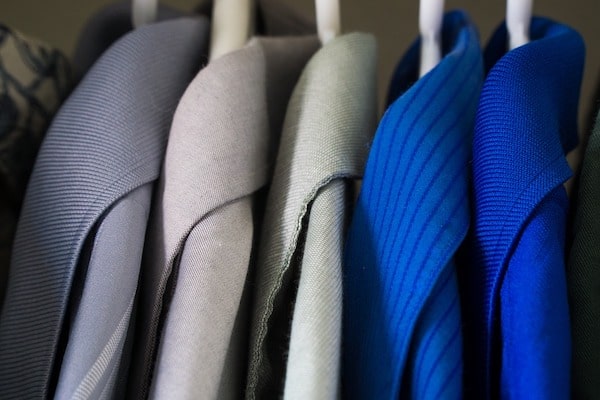
Reports indicate that we purchase 400 percent more clothing per year than we did 20 years ago. It’s no wonder we have overstuffed closets and dressers. Additionally, experts tell us that the fashion industry has a hugely detrimental effect on our environment – from the water and chemicals used to produce clothing to the discarded garments that clog up our landfills. However, there is good news: we can still have a stylish wardrobe and uncluttered closets by following a few simple rules for buying clothes.
Look at Your Lifestyle
When we examine our lifestyles, we can make decisions about the clothes we need to have. Take a few minutes and map out your weekly schedule. Note how often you wear office wear vs. fitness wear. What types of outfits do you wear during your leisure time? Next, examine your laundry and dry-cleaning schedules. This will allow you to figure out the number of each type of garment you need. For example, someone who does laundry on a daily basis might not need as many sets of fitness clothes as someone who does laundry only once a week.
When you know what items work with your lifestyle, you won’t be tempted to purchase items that aren’t appropriate – and you will know how many of which garments you do need.
Fashionista, Know Thyself
One look at Wikipedia’s Clothing Sizes article will convince you that consistency in clothing sizes is inconsistent and complicated. You might take a size 6 shirt in one store and a size 10 in another but measured against each other, both shirts are the same size! It is so frustrating!
Take the time to go to a tailor and get measured by a professional. Keep your measurements handy when buying clothes. You may also wish to carry a small measuring tape with you to measure clothing before you even try it on.
Women should definitely stop in at a boutique for a bra/undergarment fitting. Not everyone is wearing the wrong bra size but sizes are so inconsistent between shops, it makes it difficult to buy a consistent size. Knowing your measurements in inches/centimetres will help you buy the right size no matter which store you visit.
While you are thinking about your measurements, think about what colours, shapes, and textures you prefer. There is no point in buying a wool sweater if it feels too itchy to wear. Likewise, stay away from colours that don’t look good on you even if it is the in colour this year.
If finding ideal styles and colours to complement you and match your lifestyle is a bit overwhelming, consider hiring an Image Consultant. Look for someone who is certified by the Association of Image Consultants International. My Professional Organizing colleague, Geralin Thomas of Metropolitan Organizing, tells you how to build the ultimate wardrobe with clothing capsules.
Buy Quality Clothing That Will Last
When you determine what clothes suit you and your lifestyle, invest in stylish, durable clothing. There is more to buying great clothes than looking at the price tag or brand name. Look closely at the garment for craftsmanship including extra fabric in the seams (so a tailor can make sizing adjustments), patterns that match up, button and buttonhole stitching, and more. We recommend these great articles for more information on choosing clothes that will last.
- How to Buy Clothes That Are Built to Last by Kendra Pierre-Louis at the New York Times.
- Pro-tips for buying clothes that will last years, not weeks by Marc Bain at Quartz.
- An Actually Practical Guide to Shopping for High-Quality Clothes by The Luxe Strategist
- How to Identify Quality Clothing | Don’t Get Ripped Off Buying Menswear from Real Men Real Style
And remember, you don’t have to buy new clothes to find great clothes. Thrift shops and consignment stores often have high-quality garments for a fraction of the price of regular retail outlets.
Treat Your Clothing Well
Now that you’ve spent some time and maybe some money on building a wardrobe, it is important to store the clothes properly to maintain their quality.
- Stretchy clothes such as sweaters, knits, t-shirts, etc. should be folded. It will help them keep their shape. Place tissue between layers of delicate knits such as cashmere.
- Durable garments like jeans and other heavy trousers can also be folded. If space to store folded clothing is limited, these items could also be hung on sturdy hangers.
- Hang pants by the cuff from a trouser hanger with clips. Hang skirts by the waistband. If the skirt is delicate, place a piece of white cotton or linen between the skirt and the clips.
- Hang items that wrinkle easily such as silk, linen, cotton, etc. If a garment has hanging loops stitched inside, use them. By attaching the loops to the hanger, you take the weight off more delicate areas of the garment.
- Store suits and outwear on strong hangers with wide shoulders so they keep their shape.
- When hanging shirts, button the top button and every other button to help the shirt keep its shape.
- Don’t squash suits or dress shirts in a crowded closet or you may cause permanent creases in the collars and lapels.
Do you need some help transforming your closet? Out of Chaos would be happy to help. Contact us through our website today.
Image by Steve Adcock from Pixabay
